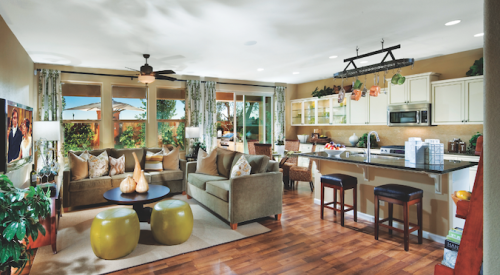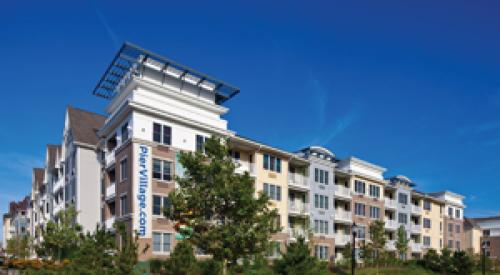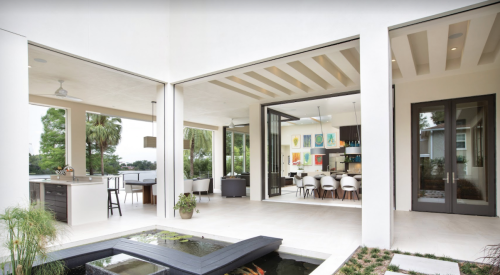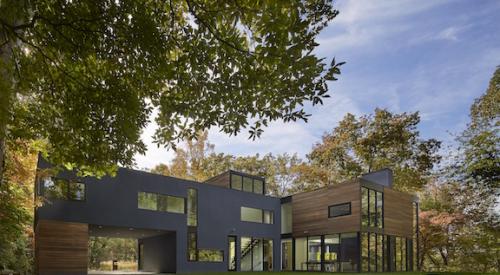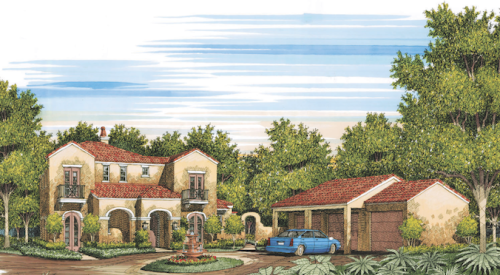|
Some builders still call it the family room, while others have adopted the contemporary term great room. Labels aside, industry experts agree this multipurpose space is here to stay. In modestly priced production homes or high-end custom residences, today's buyers are expecting more from it in function and style.
"It really doesn't matter what you call it," says builder Jay Fechtel, president of The Fechtel Company in Tampa. "This is the place where the family is hanging out. In terms of usage, this is definitely one of the most important rooms in the house for our buyers."
The typical great room is an open, informal living space at the back of the home that has both a physical and visual connection to the kitchen and informal dining area. Today's most successful great rooms allow the homeowner to relax, watch television, entertain, supervise children's homework, visit with the cook in the kitchen, or simply contemplate their outdoor environment.
 Furniture arrangement in the great room should create one or more conversation areas with a definite focal point, such as a fireplace in this project by builder Jay Fechtel. Photo by George Cott |
"The great room is the social center of the house," says Orlando-based interior designer Kay Green, a recognized industry leader in merchandising model homes for builders in all price ranges throughout the eastern, central and southern U.S.
"The great room has really emerged in our market in a big way over the past five years," says architect Robert Hidey, whose residential architectural firm Robert Hidey Architects in Irvine, Calif., designs multi-family, single-family and custom homes for some of the country's leading builders. "We include one in just about every set of plans that we do. People just naturally gravitate to the kitchen and the space adjoining it — the great room. No matter what you do you just can't get them out of there."
Go With the Flow"Even though it's located at the rear of the home, the great room's function as a connection space is very important," says Green. "Traffic is constantly flowing through it to some other part of the house."
Fechtel agrees. "From a horizontal perspective, the most important element of the great room is its link to other spaces, particularly to the outdoor living area."
The great room is also the primary gathering spot for the family. "Great rooms can be difficult to design for because of all of the things that you have going on in there," says Green. Fixed elements such as fireplaces and windows pose a significant challenge for furnishing the space without impacting traffic flow through it.
 Having an indoor/outdoor connection is an important element of any successful great room, says architect Robert Hidey. Photo by Jeff Smith and Steve Walker |
The popular acceptance of the combined great room/kitchen as the principal entertainment venue in the home has led to another interesting trend, says Hidey. Small-scale, secondary cooking facilities — in either a corner of the kitchen that is blocked from view from the great room or in a separate but adjoining nook or hallway — are becoming more common and hide meal preperation clutter.
Turn Down the VolumeBuilders have found that one of the drawbacks to a wide-open great room is poor sound quality. A high ceiling and few walls permit ambient noise from adjoining rooms to compete with conversation or TV in the great room.
"It's a good idea for builders to address the problem of excessive sound transmission in open spaces such as great rooms," says Mike Comito, vice president of design and construction for Marshall Building Enterprises, a Denver-area residential construction firm. "You can really make a big difference by paying attention to the insulation package that you offer."
Comito recommends insulating not only exterior walls, but also ceilings, interior walls and floors. "Most people do not realize how much noise actually originates from the flooring." Ceiling details such as coffers and beams also help by dampening sound from above.
Details to Complete the Look  Interior Architecture, including columns, archways and beamed ceilings, provides definition to the great room space without restricdting views. Photo by George Cott |
Natural wood for ceiling beams, millwork and floors is popular in all markets, say the experts. Wide-plank, distressed wood flooring has replaced tile as the No. 1 choice for the great room for his buyers, says Fechtel. He also recommends using different finishes in the great room than in other areas of the house.
"Interior architecture is a very big element in great rooms today," says Hidey. "One reason is that the quality of the materials that are available has really been dialed up in recent years.
"Not only does the Internet provide more resources for products than ever before, but manufacturing processes for everything from doors and millwork to cast-stone fireplace mantles are so much better that you can get things made today that you couldn't five years ago. You can take houses at all price ranges to a more authentic level architecturally and remain competitive in cost."
Fine Tune Your FocusIn most cases, great rooms feature several focal points that change depending on how the space is being used at the time.
"The great room may not necessarily contain the largest TV in the house," says Fechtel, "but in most cases it needs to have one somewhere."
The television's location and its relationship to seating is something that should be considered while the great room is still in its design stage, recommends Thad Glavin, managing partner with LouisClark, an Evanston, Ill.-based company that provides custom technology and entertainment systems for residences.
Don't overlook the need for some type of closet or storage space to hold the supporting audio/visual equipment, he recommends. Consulting with a technology specialist during the design stage may avert costly changes down the road.
|
